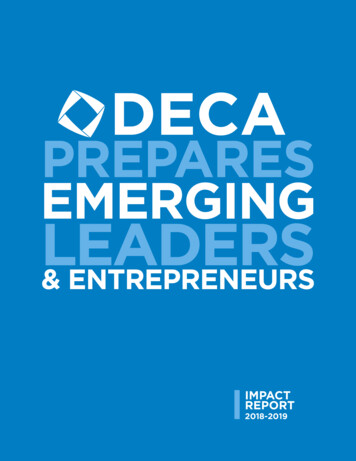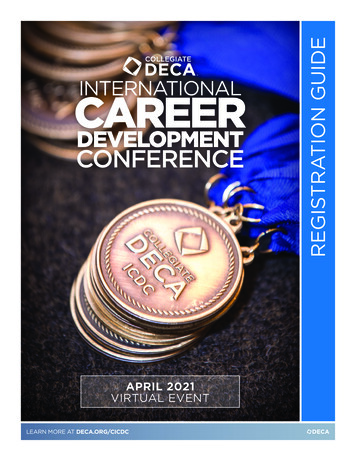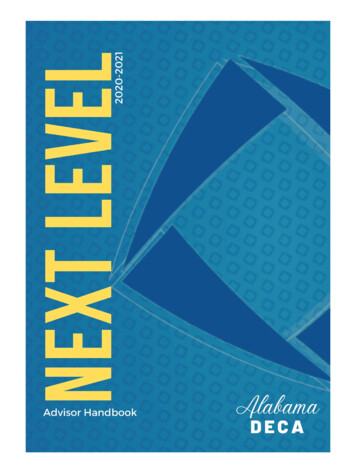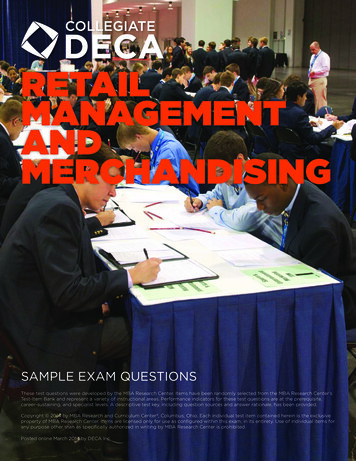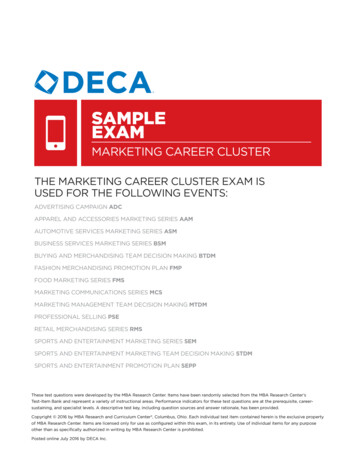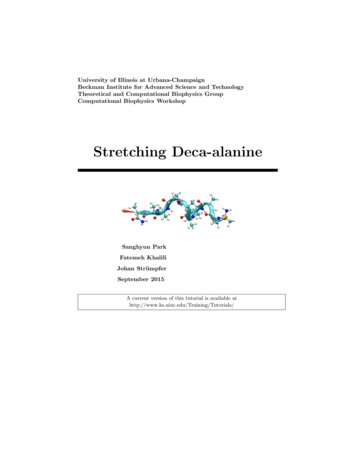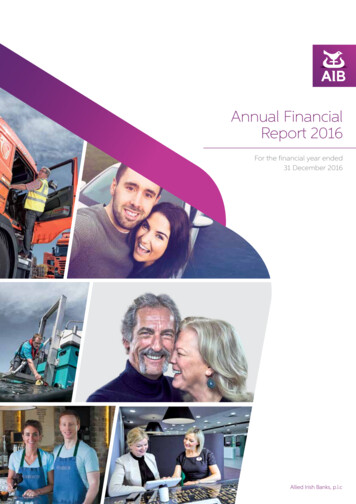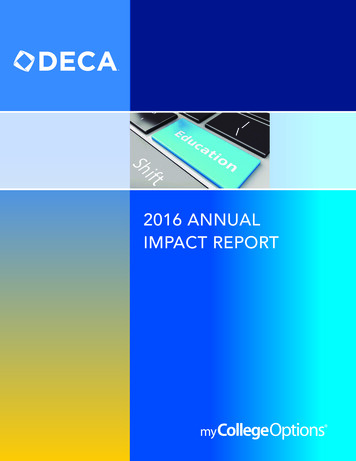
Transcription
2016 ANNUALIMPACT REPORT
Table of ContentsImpact Report FindingsDECA Members are College Ready.4-5DECA Members are Career Ready.6About DECA:For nearly 70 years, DECA has impactedthe lives of more than ten million students,educators, school administrators andbusiness professionals. Our core focus hasremained consistent throughout and iscaptured in our mission: DECA preparesemerging leaders and entrepreneurs for careers in marketing, finance, hospitality andmanagement in high schools andcolleges around the globe.DECA Provides Enrichment for Advisors.7more than 224,500 members in all 50 United States, theDistrict of Columbia, Canada, China, Germany, Guam,Honduras, Korea, Mexico, Puerto Rico and Spain. TheUnited States Congress, the United States Departmentof Education and state, district and international departments of education authorize DECA’s programs.ABOUT THE MEMBERSDECA members understand the critical need to obtaintheir high school diplomas, as well as the valuableDECA’s programs and activities constantly evolve as wea college degree. DECA students seek challengingapply cutting edge educational research and use thecourses and advanced programs of study, and pursuelatest technology to engage both educators and stu-college and career readiness with determination thatdents and remove barriers to participation. DECA’s ex-outpaces the national average. In addition, the morecellent results are created by providing co-curricular pro-engaged members are with DECA’s competitivegrams that integrate into classroom instruction, helpingprograms, the higher their GPAs, and the more likelystudents apply learning, connect to business and thethey are to be successful self-challengers, choosingcommunity and understand the value of competition.more relevant business courses and rigorous classesOur student members leverage their DECA experiencesthan their peers.professionally responsible, experienced leaders.DECA offers two unique student divisions. The HighSchool Division includes 211,000 members in 3,500schools, and the Collegiate Division includes over13,500 members in 250 colleges and universities. DECAInc. is a 501(c)(3) not-for-profit student organization with12Choosing the most challenging courses and beginningtheir career preparations early, DECA members willbecome our future business people, entrepreneursResearch Methodology.8around the world are seeking graduates withAppendices:coveted 21st Century Skills: creativity, critical2016 DECA Student Survey.10thinking, problem-solving, decision-making andthe motivation for lifelong learning. DECA putstremendous focus on developing these skills in2016 DECA State ConferenceRegistration Form .11Comprehensive Learning Program activities are2016 DECA International ConferenceRegistration Form .13cross-walked to the Framework for 21st Century2016 DECA Educator Questionnaire.15emerging leaders and entrepreneurs. All of DECA’sconnection between what they are currently learning andto become academically prepared, community oriented,In addition to general knowledge, businessesLearning. As members progress through DECA’slearning program, they demonstrate a highlyadvanced understanding and ability to executethese skills. They also gain direct exposure tothe expectations that businesses have fortheir future employees and executives.This Annual Impact Report highlightsthe college and career readinessof DECA members at all levels ofparticipation – in a DECA chapter,at a State Career DevelopmentConference (SCDC) and at DECA’sInternational Career DevelopmentConference (ICDC).and professionals. DECA members are more likely toattend college and are significantly more likely to majorin business and business-related specialties such asaccounting and marketing.23
DECA’s Members Are College ReadyGrade Point AverageBusiness Courses TakenDECA members are top achievers:the more involved they are inDECA’s competitive program,the higher their GPAs.DECA members understand the need for career preparation and choose to enroll in more business courses thanother business students.“A” Average85% 21% 22%Management/Administration11%17% 20%Sports tality & Tourism%%%%31%%The level of engagement with DECA has a directcorrespondence to those members who seek outadvanced courses and excel academically.College Type sICDCParticipantsState College/University86%84%77%76%Private College/University30%36%62%64%Community/Junior College13%12%4%6%Vocational/Technical ipantsICDCParticipantsSchool of Business15%36%56%61%School of Communications3%6%9%11%School of 1%11%Advertising0%2%5%5%Business siness (International)1%5%8%10%Communications/Public %4%5%Specialized Degree Program InterestsCollege Major/Future Career InterestsAdvanced Course TakingDECA members are self-challengers who choose to enroll in the advancedprograms that offer them better preparation for college and ICDCParticipantsAdvancedPlacement CreditCoursesCareer andTechnical (CTE)16%18%26%32%12%22%19%22%General eratedPrograms9%7%16%18%Marketing1%8%15%19%Other AdvanceProgramsInternationalBaccalaureate (IB)11%10%14%14%Sports 1%45
DECA Members Are Career ReadyMembers arePrepared toBecome LeadersMy DECAexperiences have DECA multiplies the positive impact on its members by providing substantialtools that help educators increase their classroom effectiveness.Members say that their DECA experiencesinfluence their career plans. Members who aremore committed to their DECA membershipssay this at a much higher rate.First, DECA’s co-curricular model aligns with key accountabilities outlined in the NationalCurriculum Standards, Career Clusters , Common Core Standards and the Framework for 21stCentury Learning. Second, DECA provides its educators with continuing education programsand support for integrating this high level learning program into the classroom. The impactis demonstrated through generations of educators engaging DECA’s co-curricular learningprogram and professional learning series.Members Gain 21st Century SkillsThrough DECA activities, members 958896Gained skillsin problemsolvingLearned towork as partof a teamLearnedhow tocommunicatethoughtsand ideas%88DECA Provides Enrichment for Advisors%%DECA Impacts Teaching9197GainedcreativeskillsGained skills toimprove theirpersonal andprofessionalbehaviors%%%Empowered meto become aneffective leader88%Connected schoolto the real worldfor me77%Helped me recognizethe benefit andresponsibility ofcommunityservice5Members are Motivated for the Futurehas made teaching more meaningful79% DECAand engaging.74% DECA has helped me foster better learningrelationships with my students.resources have allowed me to better67% DECA’sintegrate DECA into classroom instruction.DECA has helped me teach more rigorous57% andrelevant content.Through DECA participation, members are 87%74%71%66%60%DECA MakesClassroomInstruction MoreRelevant Through:Influenced in attending schoolInfluenced in their college plansInfluenced to consider business erviceFundraisersDECA Advisors are EngagedPrepared academically for college and acareerInfluenced in their career plansTop 3 Ways DECA’sConnection to BusinessImpacts Classrooms79%51%Academic IntegrationCareer Clusters andpathway alignment Nine in ten (92%) DECA advisors saythat the DECA ComprehensiveLearning Program Competitive Eventshave been effective in their classrooms. Nearly half of DECA advisors say thatDECA professional development hashelped them in their classrooms. Three out of four advisors say thatthey are more involved with DECAthan any other extracurricular activity.6
Research MethodologySample DemographicsThis research was conducted by My College Options . In the fallof 2015 and spring of 2016, business educators and DECAadvisors were invited to lead an activity in the classroom, as wellas at the State and International Career DevelopmentConferences, encouraging students to register for the MyCollege Options College Planning Program. As part of thatprocess, students provided their attitudes and interests relatedto business careers and their involvement with DECA. The dataanalysis and research findings resulting from that process areshared in this report. Sampling ErrorThe margin of error and the confidence interval below are ameasurement of how well the DECA research results representthe entire student community. For example, in theory, one couldsay that if we performed the survey 100 times, the results foreach respondent would fall within the margin of error above orbelow the percentage reported 99 out of 100 times.Respondent Group.All studentsSample.45,274Estimated Population.249,250Margin of Error (MOE-99%). /- 0.05%Nonsampling ErrorIt is possible that question wording and logistical difficulties inresearch studies can introduce error or bias into the findings,in addition to that caused by non-response and sampling error.Students# of Classroom DECA Members.9,097# of SCDC Respondents.30,832# of ICDC Respondents.12,874APPENDICES# of total DECA rican Middle Eastern.2%White.60%Other.3%Prefer not to respond.8%Graduation tors# of Educator .41%School TypePublic.99%Private.1%78
1908 Association DriveReston, Va. 20191-1584703-860-5000 www.deca.orgRESEARCH FOR THE FUTUREPrepared by My College Options , the nation’s largestcollege planning program.www.mycollegeoptions.org
College Type Interests 4 National Average DECA Members SCDC Participants ICDC Participants Advanced Placement (AP) 22% 34% 66% 72% Honors Programs 31% 40% 65% 66% College-Credit Courses 16% 18% 26% 32% Career and Technical (CTE) 12% 22% 19% 22% General College Prep 55% 36% 19% 18% Gifted/Accelerated Programs
